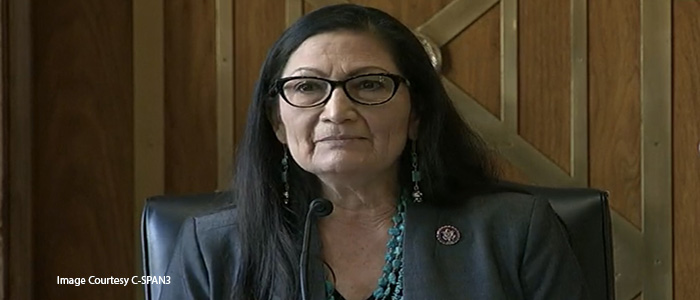If any culture can make proclamations to “take their country back” or decry the impact of being overrun by immigrants – it would be Native Americans. Even that term is a slight to a great nation of peoples who now find themselves partially named after an Italian explorer since America is named after – Amerigo Vespucci. However, the history of these tribes has come full circle as Rep. Deb Haaland (D-N.M) becomes the nations’ first Native American cabinet member as the Secretary of the Interior. The irony shouldn’t be lost on anyone.
The U.S. Department of the Interior (DOI) is a federal executive department responsible for the conservation and administration of the public lands and mineral estate of the United States. Its mission is protecting and managing the nation’s natural resources and cultural heritage for the benefit of the American people; providing scientific and scholarly information about those resources and natural hazards; and exercising the nation’s trust responsibilities and special commitments to American Indians, Alaska Natives, and island territories under U.S. administration. It oversees and fosters the use of more than 480 million acres of public lands, 700 million acres of subsurface minerals, and 1.7 billion acres of the outer continental shelf. It also includes one of the bureaus whose legacy was very detrimental to Natives.
Bureau of Indian Affairs
The DOI consists of 11 bureaus. None more destructive to Natives very existence than the Bureau of Indian Affairs (BIA). The history of massacres, assimilation, annihilation, and desecration of sacred lands, that resulted from actions of the BIA is almost invisible on the DOI website. It simply states that the Continental Congress of 1775 created a Committee on Indian Affairs headed by Benjamin Franklin “to regulate commerce with foreign nations, and among the several States, and with the Indian tribes.” However, the history of the Committee of Indians Affairs and later the BIA is filled with land grabbing schemes that stole millions of acres of land from Natives. First and foremost was The General Allotment Act of 1887 (The Dawes Act).
The Dawes Act
The Dawes Act opened tribal lands west of the Mississippi to non-Indian settlers in the first of a series of land grabs. In fact, The Dawes Act “allowed the federal government to break up tribal lands. The federal government aimed to assimilate Native Americans into mainstream US society by encouraging them towards farming and agriculture, which meant dividing tribal lands into individual plots.”
Only the Native Americans who accepted the division of tribal lands were allowed to become US citizens. The government stripped over 90 million acres of tribal land from Native Americans. Then sold that land to non-native US citizens. Native Americans controlled an estimated 150 million acres of land prior to The Dawes Act. Another intent of this Act is one African Americans know all too well – “to create divisions among Native Americans and eliminate the social cohesion of tribes.”
The History of Broken Treaties
History.com reports in Broken Treaties With Native American Tribes: that from 1778 to 1871, the United States signed some 368 treaties with various Indigenous people across North America. Many of which were broken as indicated. The list is extensive. However, one of the most heinous was perpetrated by Andrew Jackson – The 7th President of the United States.
Andrew Jackson & Indian Removal Act – 1830 – Over the decade (1814-24) that Andrew Jackson served as a federal commissioner, he negotiated nine out of 11 treaties signed with Native American tribes in the Southeast, including the Choctaws, Chickasaws, Creeks, Seminoles, and Cherokees, in which the tribes gave up a total of some 50 million acres of land in Alabama, Florida, Georgia, Tennessee, Mississippi, Kentucky, and North Carolina.
Elected president in 1828, Jackson spearheaded the Indian Removal Act (1830) through Congress, by which the U.S. government granted land west of the Mississippi River to Native tribes who agreed to give up their homelands. Though removal was supposed to be voluntary, in practice Jackson used threats of withheld payments and legal and military action to conclude nearly 70 removal treaties over the course of his presidency, opening up some 25 million acres of land in the South to white settlement, and slavery.
Full Circle
Appointing a Native Secretary of the Interior can no more make up for centuries of injustice than electing a Black President did. Nonetheless, Secretary Haaland’s appointment serves much the same purpose. It acknowledges that people of color are strong-willed and determined and cannot be crushed down under the feet of colonialism, imperialism, racism, or sexism. That is why the circle plays such an important role in Native culture. It symbolizes rebirth and a neverending cycle. Summed up – that which has no beginning or end goes on forever. This will always be their land so it’s only befitting that it now has a Native caretaker.


















Add comment